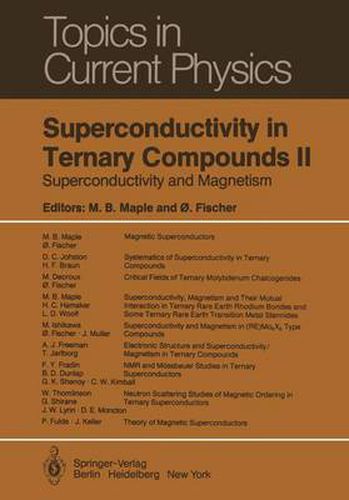Readings Newsletter
Become a Readings Member to make your shopping experience even easier.
Sign in or sign up for free!
You’re not far away from qualifying for FREE standard shipping within Australia
You’ve qualified for FREE standard shipping within Australia
The cart is loading…






This title is printed to order. This book may have been self-published. If so, we cannot guarantee the quality of the content. In the main most books will have gone through the editing process however some may not. We therefore suggest that you be aware of this before ordering this book. If in doubt check either the author or publisher’s details as we are unable to accept any returns unless they are faulty. Please contact us if you have any questions.
This Topics in Current Physics (TCP) Volume 34 is concerned primarily with super- conductivity and magnetism, and the mutual interaction of these two phenomena in ternary rare earth compounds. It is the companion of TCP Volume 32 - Superconduc- tivity in Ternary Compounds: Structural, Electronic and Lattice Properties. The interplay between superconductivity and magnetism has intrigued theoreticians and experimentalists alike for more than two decades. V. L. Ginzburg first addressed the question of whether or not superconductivity and ferromagnetism could coexist in 1957, and B. T. Matthias and coworkers carried out the first experimental inves- tigations on this problem in 1959. The early experiments were made on systems that consisted of a superconducting element or compound into which small concentrations of rare earth impurities with partially-filled 4f electron shells had been intro- duced. These dilute impurity systems were chosen because the scattering of conduc- tion electrons by parama9. netic rare earth impurity ions usually has a strong de- structive pa i r breaking effect on superconducti vity, typi ca lly drivi ng the super- conducting transition temperature to zero at impurity concentrations of only a few atomic percent. Unfortunately, analysis of these early experiments was complicated by clustering and/or the formation of short range or glassy types of magnetic order so that definitive conclusions regarding the coexistence of superconductivity and magnetism could not be reached.
$9.00 standard shipping within Australia
FREE standard shipping within Australia for orders over $100.00
Express & International shipping calculated at checkout
This title is printed to order. This book may have been self-published. If so, we cannot guarantee the quality of the content. In the main most books will have gone through the editing process however some may not. We therefore suggest that you be aware of this before ordering this book. If in doubt check either the author or publisher’s details as we are unable to accept any returns unless they are faulty. Please contact us if you have any questions.
This Topics in Current Physics (TCP) Volume 34 is concerned primarily with super- conductivity and magnetism, and the mutual interaction of these two phenomena in ternary rare earth compounds. It is the companion of TCP Volume 32 - Superconduc- tivity in Ternary Compounds: Structural, Electronic and Lattice Properties. The interplay between superconductivity and magnetism has intrigued theoreticians and experimentalists alike for more than two decades. V. L. Ginzburg first addressed the question of whether or not superconductivity and ferromagnetism could coexist in 1957, and B. T. Matthias and coworkers carried out the first experimental inves- tigations on this problem in 1959. The early experiments were made on systems that consisted of a superconducting element or compound into which small concentrations of rare earth impurities with partially-filled 4f electron shells had been intro- duced. These dilute impurity systems were chosen because the scattering of conduc- tion electrons by parama9. netic rare earth impurity ions usually has a strong de- structive pa i r breaking effect on superconducti vity, typi ca lly drivi ng the super- conducting transition temperature to zero at impurity concentrations of only a few atomic percent. Unfortunately, analysis of these early experiments was complicated by clustering and/or the formation of short range or glassy types of magnetic order so that definitive conclusions regarding the coexistence of superconductivity and magnetism could not be reached.